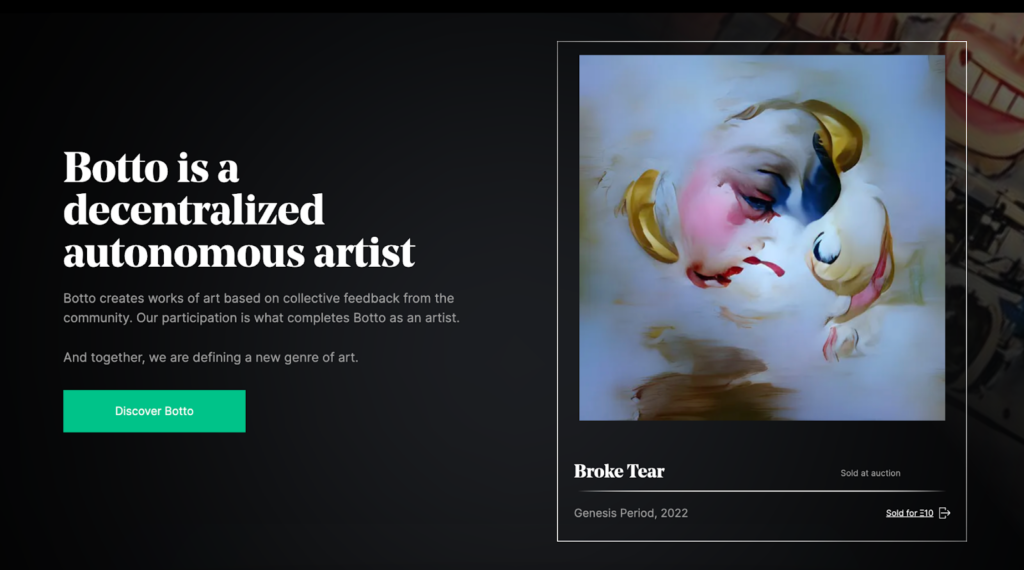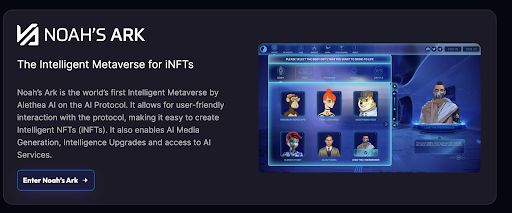How AI is Reshaping NFTs and Digital Art

AI is taking center stage in this wave of transformative tech – from GPT-4 to Midjourney V5 to Runway’s Gen-2, innovations in AI models spanning text, image, and video are becoming virtual paintbrushes for human creativity. The fusion of AI and web3 is revolutionizing digital art and NFTs, unveiling new possibilities for creators, transforming digital asset interactions, and shaping the creative process’s future. Will this rapid AI advancement lead to increased adoption and demand for digital art and NFTs?
Breaking Down Emerging Use Cases:
To better understand the implications of this AI-driven transformation, let’s delve into a few of the most promising use cases currently emerging in the digital art and NFT landscape.
- Botto is a generative AI art project governed by a DAO gathered around the token $BOTTO, pushing the boundaries of community-driven creativity at the intersection of AI, DAOs, and DeFi. Since October 2021, Botto’s art engine produces 350 drafts, called “fragments”, every week. The community votes for their weekly favorite which is minted and sold on SuperRare. The voting data is fed back to the AI, which learns from the community’s tastes, and the revenue from sales reverts to the community. Botto generates revenue through weekly art sales, royalties from secondary trades, and project collectible sales. The revenue is distributed across the community, and $BOTTO is burned according to the project’s revenue distribution model to reward the community’s participation in the growth and evolution of the project. To date, Botto has generated over 944 ETH in revenue and 1,264 ETH in total sales.

- Bicasso, a new AI art tool developed by Binance, has recently been introduced to its users, offering a fresh approach to creating images and minting them as NFTs. Drawing inspiration from popular AI art programs like Midjourney and DALL-E, Bicasso enables users to generate images using text prompts or upload existing images for further iteration. What sets Bicasso apart is its seamless integration with Binance’s native BNB chain, allowing the AI-generated images to be minted as NFTs directly on the platform. Serving as a demonstration of the potential for future marketplace infrastructure that incorporates AI art tools, the beta test limited the minting process to 10,000 NFTs. Despite some users encountering functionality issues due to high demand following the announcement, an impressive 9,214 holders successfully minted all 10,000 NFTs in under three hours, showcasing the enthusiasm for such innovative art creation methods.

- Alethea AI is making waves by developing a decentralized protocol for creating interactive and intelligent NFTs (iNFTs) using a multimodal AI system. By allowing users to generate AI characters from natural language descriptions, Alethea AI is opening a whole new world of digital assets and applications. Raising $31M to-date, the team is working to redefine storytelling and interactivity in the metaverse, enabling creators to develop unique, engaging experiences for users while driving increased interest in NFTs as a medium for artistic expression. However, adoption has been relatively small, with only 1,402 Daily UAW’s according to Dune Analytics.

In the world of GameFi, companies like Scenario, Mirror World, and Altered State Machine (ASM) are leveraging AI to generate gaming assets and transform in-game experiences.
- Scenario empowers game artists to create personalized art generators, enabling the automatic generation of thousands of new assets in their unique style. This AI-driven approach not only streamlines the game development process but also preserves the individual artist’s voice, ensuring that their creative vision is not diluted by generic AI tools. After announcing Scenario’s $6M Seed Round, Co-Founder, Emmanuel de Maistre, shared that 5,000 creators have signed up for the platform, and 20,000 more are on a waitlist. Pricing will be usage-based, starting at $20 per month with plans for higher-volume customers to follow. Their mission is to open the opportunity AI brings to the gaming industry: exponentially increased production, dramatically reduced busywork, and completely unconstrained creativity from AI-partnered artists.

- Mirror World is changing the GameFi landscape by utilizing AI-driven virtual “Mirrors” as assets for in-game characters. “Mirror World is the first artificial intelligence-driven virtual playground that brings crypto rewards to people,” says Mirror World founder and CEO Chris Zhu. “We want to build the ‘Nintendo of Web3’ with players’ beloved characters.” The company recently raised a $4M Seed round, led by Galaxy Interactive and Republic Crypto, among a host of other investors. Mirror World plans to use this round of financing to accelerate the launch of its first three games – an ARPG (action role-playing game), a PvP (player vs. player) Battle Arena, and an SLG (simulation game). Mirror World’s overall trading volume is hovering at 179.75 ETH but has struggled to scale since 2022. Mirror World is currently working with the economic team of Republic Crypto to design Tokenomics and DAO around the concept of ensuring gameplay. The goal is to bring players a better gaming experience while simultaneously promoting more sustainable economic benefits and a more open and “well-framed” economic system. The end game is to design an open, autonomous, sustainable, and asset-interoperable game world.
- Altered State Machine (ASM) is pioneering a new model of AI ownership with its decentralized protocol that allows users to own, train, and trade unique AI-powered ASM Brains as NFTs. These Brains can be used in avatars, games, and other metaverse applications, giving users unprecedented control over the AI that powers their digital experiences. FIFA recently launched the beta version of its “World Cup AI League” , a mobile strategy game powered by ASM that utilizes AI to create its characters, cosmetics, and gameplay components. ASM raised an $11M Seed Round in 2022 from top-tier investors such as TCG, Coinbase Ventures, WMG, 6th Man Ventures, Delphi Digital, Outlier Ventures, and Flamingo DAO among others.

While the adoption of AI-driven projects and use cases in the NFT space is still in its early stages, their impact reaches far beyond their immediate applications, laying the groundwork for future innovation. AI-generated content platforms, decentralized AI protocols, community-driven art auctions, and interoperable gaming assets each present distinct opportunities for growth and progress in the digital art and gaming realms.
As artists and galleries increasingly adopt AI tools for competitions and physical exhibitions, it is essential to remain cautious and discerning. While some critiques of AI artistry may be reactionary or fear-based, there are legitimate ethical concerns surrounding these tools’ creation and use. The convergence of AI and NFTs raises questions about the ownership of creative output, the potential for plagiarism, and the manipulation of AI-generated content. Recent lawsuits against companies like Stability AI and Midjourney for alleged copyright breaches in their algorithm training processes only serve to heighten these concerns. Tackling these issues will necessitate collaboration among technologists, policymakers, and the wider community, emphasizing the development of ethical guidelines and best practices that strike a balance between innovation and accountability.
As AI and NFT technologies continue to merge, they will undoubtedly reshape the world of digital art, gaming, and beyond, opening up new possibilities and inspiring further exploration of this dynamic and ever-evolving landscape.
This article has been written and prepared by Jarrod Barnes and GCR Research Team, a group of dedicated professionals with extensive knowledge and expertise in their field. Committed to staying current with industry developments and providing accurate and valuable information, GlobalCoinResearch.com is a trusted source for insightful news, research, and analysis.
Disclaimer: Investing carries with it inherent risks, including but not limited to technical, operational and human errors, as well as platform failures. The content provided is purely for educational purposes and should not be considered as financial advice. The authors of this content are not professional or licensed financial advisors and the views expressed are their own and do not represent the opinions of any organization they may be affiliated with.
*****












